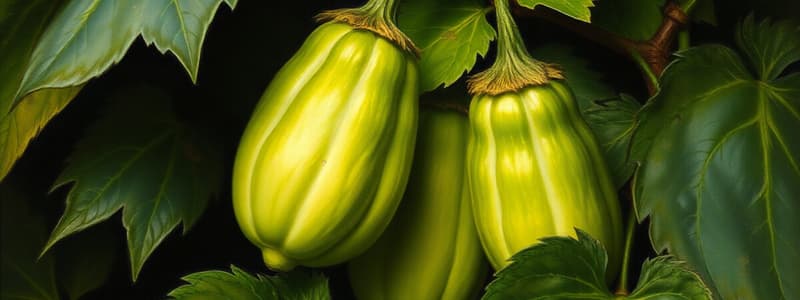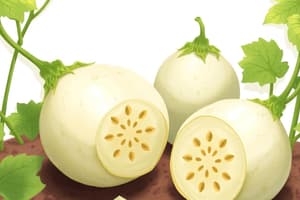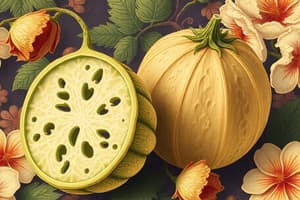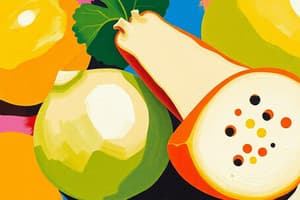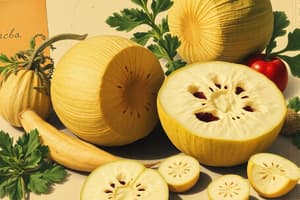Podcast
Questions and Answers
To which plant family does jicama (Pachyrhizus erosus) belong?
To which plant family does jicama (Pachyrhizus erosus) belong?
- Cucurbitaceae
- Solanaceae
- Brassicaceae
- Fabaceae (correct)
How is jicama classified in terms of its physical structure?
How is jicama classified in terms of its physical structure?
- Woody stem plant
- Herbaceous vine (correct)
- Tree
- Shrub
What type of life cycle does jicama have?
What type of life cycle does jicama have?
- Biennial
- Perennial (correct)
- Annual
- Ephemeral
What initial processing step is taken after harvesting jicama?
What initial processing step is taken after harvesting jicama?
Which regions of the world are known for the wide cultivation of jicama?
Which regions of the world are known for the wide cultivation of jicama?
What is the primary economic purpose for cultivating Jatropha curcas?
What is the primary economic purpose for cultivating Jatropha curcas?
Which of the following steps comes immediately after harvesting the Jatropha seeds?
Which of the following steps comes immediately after harvesting the Jatropha seeds?
Which processing step involves removing impurities from the extracted oil from Jatropha seeds?
Which processing step involves removing impurities from the extracted oil from Jatropha seeds?
What is the correct order of processing steps for Jatropha seeds starting from harvest?
What is the correct order of processing steps for Jatropha seeds starting from harvest?
Which method is used to encourage resin to ooze from myrrh trees?
Which method is used to encourage resin to ooze from myrrh trees?
How is myrrh resin processed after collection?
How is myrrh resin processed after collection?
Which characteristic is essential for selecting myrrh trees for harvesting?
Which characteristic is essential for selecting myrrh trees for harvesting?
What form does myrrh resin take after it dries?
What form does myrrh resin take after it dries?
What was the primary cause of the Irish Potato Famine in the mid-19th century?
What was the primary cause of the Irish Potato Famine in the mid-19th century?
Which tuber is native to the Andes Mountains of South America?
Which tuber is native to the Andes Mountains of South America?
What percentage of fresh potatoes is water?
What percentage of fresh potatoes is water?
What is a significant characteristic of the yam species mentioned?
What is a significant characteristic of the yam species mentioned?
What distinguishes true roots from other underground plant structures?
What distinguishes true roots from other underground plant structures?
Which method is used to remove irritant calcium oxalate crystals from Taro?
Which method is used to remove irritant calcium oxalate crystals from Taro?
Which of the following statements about bulbs is incorrect?
Which of the following statements about bulbs is incorrect?
Which characteristic accurately describes the plants classified as rhizomes?
Which characteristic accurately describes the plants classified as rhizomes?
Which pair of vegetables exemplifies true roots and their respective characteristics?
Which pair of vegetables exemplifies true roots and their respective characteristics?
What was a primary factor that made overland caravan trade routes increasingly dangerous?
What was a primary factor that made overland caravan trade routes increasingly dangerous?
Which of the following statements correctly describes the early impact of Vasco de Gama's discovery in 1499?
Which of the following statements correctly describes the early impact of Vasco de Gama's discovery in 1499?
What is a significant economic activity established by the Dutch and British by the mid-1800s?
What is a significant economic activity established by the Dutch and British by the mid-1800s?
Which essential oil is commonly used in the cosmetics and perfume industries, derived from a member of the Mint Family?
Which essential oil is commonly used in the cosmetics and perfume industries, derived from a member of the Mint Family?
In which culinary application is oregano primarily used?
In which culinary application is oregano primarily used?
Which of the following statements is NOT true about the historical use of spices?
Which of the following statements is NOT true about the historical use of spices?
What major outcome resulted from the Crusaders' attack on Constantinople?
What major outcome resulted from the Crusaders' attack on Constantinople?
Which chemicals are primarily responsible for the flavors and aromas associated with spices?
Which chemicals are primarily responsible for the flavors and aromas associated with spices?
What was a significant impact of Marco Polo's expeditions on spice trade in Europe?
What was a significant impact of Marco Polo's expeditions on spice trade in Europe?
What distinguishes cellulose from starch in terms of its molecular structure?
What distinguishes cellulose from starch in terms of its molecular structure?
Which of the following represents a significant role of amylase in the digestive process?
Which of the following represents a significant role of amylase in the digestive process?
Which characteristic of bioethanol makes it a sustainable alternative to gasoline?
Which characteristic of bioethanol makes it a sustainable alternative to gasoline?
How does the structure of starch impact its digestibility compared to cellulose?
How does the structure of starch impact its digestibility compared to cellulose?
What is the primary structural difference between monosaccharides and disaccharides?
What is the primary structural difference between monosaccharides and disaccharides?
What is considered an efficient energy balance ratio for bioethanol production?
What is considered an efficient energy balance ratio for bioethanol production?
What factor is likely responsible for Brazil achieving higher energy balances in bioethanol production compared to the U.S.?
What factor is likely responsible for Brazil achieving higher energy balances in bioethanol production compared to the U.S.?
Which of the following plants is NOT mentioned as a potential source for bioethanol production due to high cellulose content?
Which of the following plants is NOT mentioned as a potential source for bioethanol production due to high cellulose content?
What was a social impact of establishing large plantations of sugar cane in the Caribbean?
What was a social impact of establishing large plantations of sugar cane in the Caribbean?
What type of fats are characterized by having one or more double bonds in the fatty acid chain?
What type of fats are characterized by having one or more double bonds in the fatty acid chain?
Which process, involving heating oil in a vacuum with water, converts unsaturated fatty acids into a more stable form?
Which process, involving heating oil in a vacuum with water, converts unsaturated fatty acids into a more stable form?
Which type of double bond arrangement in fatty acids results in a higher melting point and stability?
Which type of double bond arrangement in fatty acids results in a higher melting point and stability?
Which of the following types of oils is primarily used in paints and varnishes due to its high levels of unsaturation?
Which of the following types of oils is primarily used in paints and varnishes due to its high levels of unsaturation?
What health risk is associated with the consumption of trans fatty acids produced during hydrogenation?
What health risk is associated with the consumption of trans fatty acids produced during hydrogenation?
What is the primary method through which biodiesel is produced from plant oils?
What is the primary method through which biodiesel is produced from plant oils?
What is the significant downside of biodiesel related to its emissions compared to petrodiesel?
What is the significant downside of biodiesel related to its emissions compared to petrodiesel?
Which plant oil has the highest potential yield for biodiesel production based on area cultivated?
Which plant oil has the highest potential yield for biodiesel production based on area cultivated?
What characteristic of soap molecules allows them to effectively clean grease and dirt?
What characteristic of soap molecules allows them to effectively clean grease and dirt?
Which historical civilization is attributed with some of the earliest records of soap use?
Which historical civilization is attributed with some of the earliest records of soap use?
What is the primary difference between modern detergents and traditional soaps?
What is the primary difference between modern detergents and traditional soaps?
Which plant oil is mentioned as producing a mild soap?
Which plant oil is mentioned as producing a mild soap?
What is the purpose of using lye in the soap-making process?
What is the purpose of using lye in the soap-making process?
What is the primary advantage of using natural rubber for the sidewalls of modern radial tires?
What is the primary advantage of using natural rubber for the sidewalls of modern radial tires?
Which characteristic of synthetic rubber makes it less desirable than natural rubber?
Which characteristic of synthetic rubber makes it less desirable than natural rubber?
Which issue was associated with Charles Macintosh's method for waterproofing cloth?
Which issue was associated with Charles Macintosh's method for waterproofing cloth?
What critical discovery significantly increased the importance of rubber in the 19th century?
What critical discovery significantly increased the importance of rubber in the 19th century?
What is the primary reason for the Para rubber tree's latex production in response to wounding?
What is the primary reason for the Para rubber tree's latex production in response to wounding?
Which process alters natural rubber to improve its durability and elasticity?
Which process alters natural rubber to improve its durability and elasticity?
What component is primarily responsible for stabilizing natural rubber during vulcanization?
What component is primarily responsible for stabilizing natural rubber during vulcanization?
Which factor has contributed to the shift of natural rubber production from its native region to Southeast Asia and Africa?
Which factor has contributed to the shift of natural rubber production from its native region to Southeast Asia and Africa?
What is the structural significance of polyterpenes in plant latex?
What is the structural significance of polyterpenes in plant latex?
What specific property of plant fibres influences their application in various products?
What specific property of plant fibres influences their application in various products?
Which method of fibre extraction involves the use of stagnant water for microbial decomposition?
Which method of fibre extraction involves the use of stagnant water for microbial decomposition?
What differentiates Gossypium hirsutum from other cotton species in terms of agricultural practices?
What differentiates Gossypium hirsutum from other cotton species in terms of agricultural practices?
What is the primary advantage of using the ginning process for cotton fibre extraction?
What is the primary advantage of using the ginning process for cotton fibre extraction?
Which ancient civilization provides archaeological evidence of early cotton use?
Which ancient civilization provides archaeological evidence of early cotton use?
What is the primary purpose of mercerization in cotton processing?
What is the primary purpose of mercerization in cotton processing?
What unique feature differentiates kapok fibers from cotton fibers?
What unique feature differentiates kapok fibers from cotton fibers?
What is the approximate global annual production of cotton in bales?
What is the approximate global annual production of cotton in bales?
Which step in cotton processing involves the use of caustic soda bleach?
Which step in cotton processing involves the use of caustic soda bleach?
What percentage of fresh cotton fibers is made up of cellulose?
What percentage of fresh cotton fibers is made up of cellulose?
Which coffee species is primarily known for its superior flavor and is often used in higher-quality fresh brewed coffees?
Which coffee species is primarily known for its superior flavor and is often used in higher-quality fresh brewed coffees?
What is the average annual harvest yield per coffee plant?
What is the average annual harvest yield per coffee plant?
Which factor does NOT influence the final flavor of coffee?
Which factor does NOT influence the final flavor of coffee?
What type of growing conditions do coffee plants thrive in?
What type of growing conditions do coffee plants thrive in?
What is the primary factor that distinguishes black tea production from green tea production?
What is the primary factor that distinguishes black tea production from green tea production?
Which of the following locations was NOT historically associated with the introduction of coffee to European markets?
Which of the following locations was NOT historically associated with the introduction of coffee to European markets?
Which characteristic of tea production directly influences its flavor profile?
Which characteristic of tea production directly influences its flavor profile?
In which year were coffee houses first established in London?
In which year were coffee houses first established in London?
Which of these factors contributed to the quick spread of coffee in Europe during the 17th century?
Which of these factors contributed to the quick spread of coffee in Europe during the 17th century?
What is the main purpose of the gentle pressing in the winemaking process?
What is the main purpose of the gentle pressing in the winemaking process?
What does the French classification system emphasize to maintain wine quality?
What does the French classification system emphasize to maintain wine quality?
Which wine classification is intended for everyday local consumption in France?
Which wine classification is intended for everyday local consumption in France?
What factor is primarily responsible for the premium pricing of certain small area wines in France?
What factor is primarily responsible for the premium pricing of certain small area wines in France?
Which winemaking country has been traditionally known for its significant contributions to the global wine industry?
Which winemaking country has been traditionally known for its significant contributions to the global wine industry?
Which grape varieties are exclusively grown in the Burgundy region?
Which grape varieties are exclusively grown in the Burgundy region?
What is the primary characteristic that distinguishes Champagne from other sparkling wines?
What is the primary characteristic that distinguishes Champagne from other sparkling wines?
In the Bordeaux region, which type of wines are primarily produced in the northern area?
In the Bordeaux region, which type of wines are primarily produced in the northern area?
What is the lowest classification of wine under Italian wine laws introduced in 1963?
What is the lowest classification of wine under Italian wine laws introduced in 1963?
What characteristic is essential for the production of traditional Champagne?
What characteristic is essential for the production of traditional Champagne?
What characteristic of the grapevine Vitis vinifera contributes to its selection in winemaking?
What characteristic of the grapevine Vitis vinifera contributes to its selection in winemaking?
Which process differentiates the production methods of red and white wine?
Which process differentiates the production methods of red and white wine?
What was the primary historical impact of the introduction of phylloxera to European grape vines?
What was the primary historical impact of the introduction of phylloxera to European grape vines?
What is a common step in the fermentation process of crushed grapes for winemaking?
What is a common step in the fermentation process of crushed grapes for winemaking?
Which statement best describes the relationship between grape variety propagation and winemaking?
Which statement best describes the relationship between grape variety propagation and winemaking?
Which statement accurately reflects the historical contributions of plants to medicine?
Which statement accurately reflects the historical contributions of plants to medicine?
Which of the following percentages indicates the proportion of Western medicines that are plant-based?
Which of the following percentages indicates the proportion of Western medicines that are plant-based?
What complex chemicals are still primarily extracted from plants due to challenges in synthetic production?
What complex chemicals are still primarily extracted from plants due to challenges in synthetic production?
Which of the following substances is classified as an alkaloid?
Which of the following substances is classified as an alkaloid?
What was a significant historical factor influencing the esteem of those knowledgeable about medicinal plants?
What was a significant historical factor influencing the esteem of those knowledgeable about medicinal plants?
Which of the following statements regarding the global trade of medicinal plants is true?
Which of the following statements regarding the global trade of medicinal plants is true?
How do secondary products in plants primarily benefit them?
How do secondary products in plants primarily benefit them?
What role does quinidine play in medicine?
What role does quinidine play in medicine?
What is the primary purpose of secondary products in plants lacking an excretory system?
What is the primary purpose of secondary products in plants lacking an excretory system?
What is the primary psychoactive component found in cannabis?
What is the primary psychoactive component found in cannabis?
Which of the following statements correctly describes the historical use of peyote cactus?
Which of the following statements correctly describes the historical use of peyote cactus?
What was a significant consequence of the ban on cannabis in the 1930s?
What was a significant consequence of the ban on cannabis in the 1930s?
Which regions are noted for having tolerant cannabis consumption laws?
Which regions are noted for having tolerant cannabis consumption laws?
Which form of cannabis is primarily made from the purified concentrated resin of the plant?
Which form of cannabis is primarily made from the purified concentrated resin of the plant?
What physiological effects does nicotine derived from tobacco have on the central nervous system?
What physiological effects does nicotine derived from tobacco have on the central nervous system?
What is one potentially dangerous effect of scopolamine, a tropane alkaloid found in solanaceous plants?
What is one potentially dangerous effect of scopolamine, a tropane alkaloid found in solanaceous plants?
What is a known traditional use for the seeds of the morning glory plant?
What is a known traditional use for the seeds of the morning glory plant?
What unusual characteristic can result from chewing betel palm nut?
What unusual characteristic can result from chewing betel palm nut?
Which of the following psychoactive drugs is primarily classified as a hallucinogen and can cause feelings of flying?
Which of the following psychoactive drugs is primarily classified as a hallucinogen and can cause feelings of flying?
Flashcards
Jicama's Family
Jicama's Family
Jicama, also known as Pachyrhizuserosus, belongs to the legume family, Fabaceae.
What type of plant is jicama?
What type of plant is jicama?
Jicama is a herbaceous perennial vine. A vine is a type of plant with a long, trailing stem that needs support to climb.
Where did Jicama's journey begin?
Where did Jicama's journey begin?
Jicama likely originated in Mexico and Central America. Evidence suggests it was first domesticated in this region.
Jicama's global popularity
Jicama's global popularity
Signup and view all the flashcards
What part of Jicama do we eat?
What part of Jicama do we eat?
Signup and view all the flashcards
What family does Jatropha curcas belong to?
What family does Jatropha curcas belong to?
Signup and view all the flashcards
Is Jatropha curcas a herb, shrub, or tree? And what is its lifespan?
Is Jatropha curcas a herb, shrub, or tree? And what is its lifespan?
Signup and view all the flashcards
Where is Jatropha curcas originally from?
Where is Jatropha curcas originally from?
Signup and view all the flashcards
Why is Jatropha curcas grown?
Why is Jatropha curcas grown?
Signup and view all the flashcards
How is oil extracted from Jatropha curcas?
How is oil extracted from Jatropha curcas?
Signup and view all the flashcards
Myrrh's family?
Myrrh's family?
Signup and view all the flashcards
Myrrh: Tree or herb?
Myrrh: Tree or herb?
Signup and view all the flashcards
Where do Myrrh trees grow?
Where do Myrrh trees grow?
Signup and view all the flashcards
What part of the Myrrh tree is used?
What part of the Myrrh tree is used?
Signup and view all the flashcards
How is Myrrh harvested and processed?
How is Myrrh harvested and processed?
Signup and view all the flashcards
What are vegetables?
What are vegetables?
Signup and view all the flashcards
What are root crops?
What are root crops?
Signup and view all the flashcards
What is a taproot?
What is a taproot?
Signup and view all the flashcards
What is a bulb?
What is a bulb?
Signup and view all the flashcards
What is a tuber?
What is a tuber?
Signup and view all the flashcards
Potato Tuber
Potato Tuber
Signup and view all the flashcards
Potato (Solanum tuberosum)
Potato (Solanum tuberosum)
Signup and view all the flashcards
Potato Blight (Phytophthora infestans)
Potato Blight (Phytophthora infestans)
Signup and view all the flashcards
Corm
Corm
Signup and view all the flashcards
Taro (Colocasia esculenta)
Taro (Colocasia esculenta)
Signup and view all the flashcards
What are spices?
What are spices?
Signup and view all the flashcards
What are essential oils in spices?
What are essential oils in spices?
Signup and view all the flashcards
How did spices arrive in Europe?
How did spices arrive in Europe?
Signup and view all the flashcards
How did Venice become a center of spice trade?
How did Venice become a center of spice trade?
Signup and view all the flashcards
How did Marco Polo contribute to European spices?
How did Marco Polo contribute to European spices?
Signup and view all the flashcards
Why did the spice trade become difficult?
Why did the spice trade become difficult?
Signup and view all the flashcards
What was Vasco de Gama's key discovery?
What was Vasco de Gama's key discovery?
Signup and view all the flashcards
Who controlled the spice trade after the Portuguese?
Who controlled the spice trade after the Portuguese?
Signup and view all the flashcards
Where did the Dutch and British develop plantations?
Where did the Dutch and British develop plantations?
Signup and view all the flashcards
How did plantations change the spice trade?
How did plantations change the spice trade?
Signup and view all the flashcards
Monosaccharide
Monosaccharide
Signup and view all the flashcards
Disaccharide
Disaccharide
Signup and view all the flashcards
Starch
Starch
Signup and view all the flashcards
Cellulose
Cellulose
Signup and view all the flashcards
Bioethanol
Bioethanol
Signup and view all the flashcards
Energy Balance for Bioethanol
Energy Balance for Bioethanol
Signup and view all the flashcards
Sugarcane
Sugarcane
Signup and view all the flashcards
Bagasse
Bagasse
Signup and view all the flashcards
Sugar Triangle
Sugar Triangle
Signup and view all the flashcards
Cellulose for Bioethanol
Cellulose for Bioethanol
Signup and view all the flashcards
What are plant oils?
What are plant oils?
Signup and view all the flashcards
What are saturated fats?
What are saturated fats?
Signup and view all the flashcards
What are unsaturated fats?
What are unsaturated fats?
Signup and view all the flashcards
What is hydrogenation?
What is hydrogenation?
Signup and view all the flashcards
What are trans fats?
What are trans fats?
Signup and view all the flashcards
Unsaturated Fats
Unsaturated Fats
Signup and view all the flashcards
Saponification
Saponification
Signup and view all the flashcards
Soap Molecule
Soap Molecule
Signup and view all the flashcards
Sodium Laureth Sulfate (SLES)
Sodium Laureth Sulfate (SLES)
Signup and view all the flashcards
Trans Fat
Trans Fat
Signup and view all the flashcards
Biodiesel
Biodiesel
Signup and view all the flashcards
Transesterification
Transesterification
Signup and view all the flashcards
Canola Oil
Canola Oil
Signup and view all the flashcards
Energy Balance of Biodiesel
Energy Balance of Biodiesel
Signup and view all the flashcards
Viscosity
Viscosity
Signup and view all the flashcards
Hydrogenation
Hydrogenation
Signup and view all the flashcards
What is the composition of plant latex?
What is the composition of plant latex?
Signup and view all the flashcards
What is the function of latex in plants?
What is the function of latex in plants?
Signup and view all the flashcards
What is vulcanization and what are its effects on rubber?
What is vulcanization and what are its effects on rubber?
Signup and view all the flashcards
How does vulcanization affect the properties of natural rubber?
How does vulcanization affect the properties of natural rubber?
Signup and view all the flashcards
What are the energy storage properties of cured natural rubber?
What are the energy storage properties of cured natural rubber?
Signup and view all the flashcards
Ginning
Ginning
Signup and view all the flashcards
Retting
Retting
Signup and view all the flashcards
Decortication
Decortication
Signup and view all the flashcards
Cotton
Cotton
Signup and view all the flashcards
Vulcanization
Vulcanization
Signup and view all the flashcards
Energy Storage of Cured Rubber
Energy Storage of Cured Rubber
Signup and view all the flashcards
Cotton Fiber
Cotton Fiber
Signup and view all the flashcards
Combing/Carding Cotton
Combing/Carding Cotton
Signup and view all the flashcards
Kapok Tree (Ceiba pentandra)
Kapok Tree (Ceiba pentandra)
Signup and view all the flashcards
Coffee Species
Coffee Species
Signup and view all the flashcards
Arabica vs Robusta
Arabica vs Robusta
Signup and view all the flashcards
Coffee Flavor Factors
Coffee Flavor Factors
Signup and view all the flashcards
Top Coffee Producers
Top Coffee Producers
Signup and view all the flashcards
Guarana
Guarana
Signup and view all the flashcards
Coffee Bean Processing
Coffee Bean Processing
Signup and view all the flashcards
Black Tea Production
Black Tea Production
Signup and view all the flashcards
Tea Plant Conditions
Tea Plant Conditions
Signup and view all the flashcards
Tea Flavor
Tea Flavor
Signup and view all the flashcards
Coffee in Europe
Coffee in Europe
Signup and view all the flashcards
Appellation d'Origine Contrôlée (AOC)
Appellation d'Origine Contrôlée (AOC)
Signup and view all the flashcards
Appellation Communale
Appellation Communale
Signup and view all the flashcards
French Wine Classification System
French Wine Classification System
Signup and view all the flashcards
Filtering Wine
Filtering Wine
Signup and view all the flashcards
Fermentation
Fermentation
Signup and view all the flashcards
Vitis vinifera
Vitis vinifera
Signup and view all the flashcards
Phylloxera
Phylloxera
Signup and view all the flashcards
Must
Must
Signup and view all the flashcards
Saccharomyces ellipsoids
Saccharomyces ellipsoids
Signup and view all the flashcards
Premier Crus
Premier Crus
Signup and view all the flashcards
Grand Crus
Grand Crus
Signup and view all the flashcards
Bordeaux
Bordeaux
Signup and view all the flashcards
Champagne
Champagne
Signup and view all the flashcards
Burgundy
Burgundy
Signup and view all the flashcards
Alkaloids
Alkaloids
Signup and view all the flashcards
Terpenoids
Terpenoids
Signup and view all the flashcards
Phenolics
Phenolics
Signup and view all the flashcards
Medicinal Plants: A Long History
Medicinal Plants: A Long History
Signup and view all the flashcards
Doctrine of Signatures
Doctrine of Signatures
Signup and view all the flashcards
Plant-Derived Medicines
Plant-Derived Medicines
Signup and view all the flashcards
Global Medicinal Plant Trade
Global Medicinal Plant Trade
Signup and view all the flashcards
Biodiesel Production
Biodiesel Production
Signup and view all the flashcards
What are psychoactive drugs?
What are psychoactive drugs?
Signup and view all the flashcards
What are alkaloids?
What are alkaloids?
Signup and view all the flashcards
What is betel nut known for?
What is betel nut known for?
Signup and view all the flashcards
What is nicotine known for?
What is nicotine known for?
Signup and view all the flashcards
What family of plants contains hallucinogenic alkaloids?
What family of plants contains hallucinogenic alkaloids?
Signup and view all the flashcards
Mescaline
Mescaline
Signup and view all the flashcards
Tetrahydrocannabinol (THC)
Tetrahydrocannabinol (THC)
Signup and view all the flashcards
Cannabis Prohibition (1930s)
Cannabis Prohibition (1930s)
Signup and view all the flashcards
Study Notes
Jicama (Pachyrhizus erosus)
- Family: Pea family (Fabaceae)
- Type of plant: Herbaceous vine
- Life cycle: Perennial (lives longer than two years)
- Native distribution: Mexico and Central America
Jicama as a Food Plant
- Domestication: First domesticated in Mexico; archaeological sites in Peru date back to 3000 BC.
- Widely grown regions: Central America and Southeast Asia.
- Historical use: A staple in Central American diets for centuries; introduced to Southeast Asia by the Spanish in the 17th century. Popular in the Philippines, China, and other regions.
Jicama Utilization
- Part used: Tuberous root (tap root system)
- Processing:
- Harvesting: Harvested from the ground.
- Peeling: Thin, brown skin peeled off using a vegetable peeler or knife.
- Cutting: Cut into sticks, cubes, or slices, depending on use.
- Preparation and consumption: Often eaten raw in salads, salsas, or as a snack; can be added to stir-fries, soups, and stews, retaining its crisp texture.
- Additional prep note: The tuberous root can be peeled or left unpeeled depending on how it will be used.
- Additional prep note: Jicama can be cut into sticks, cubes, or slices.
- Additional prep note: Some sources indicate jicama is a taproot, not a tuberous root.
- Additional prep note: Jicama is peeled by hand or using a knife or vegetable peeler.
Studying That Suits You
Use AI to generate personalized quizzes and flashcards to suit your learning preferences.
